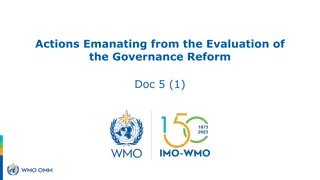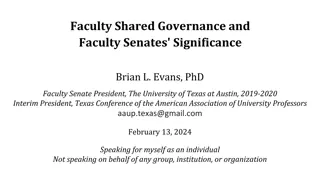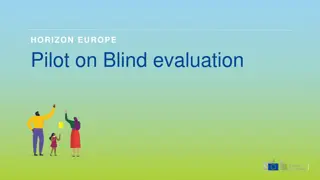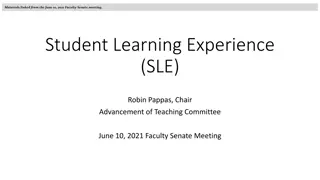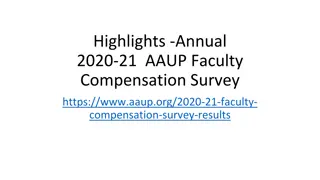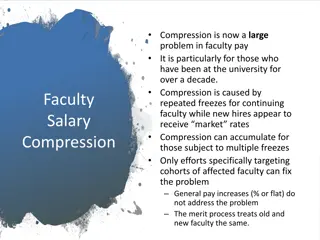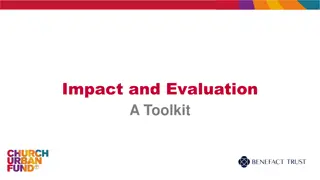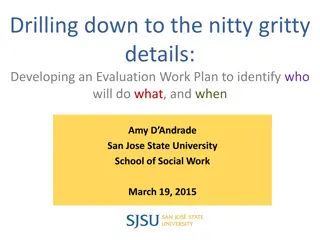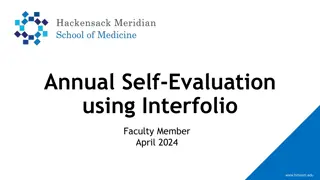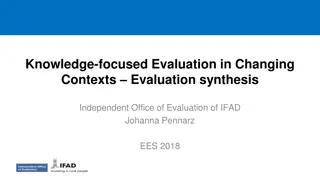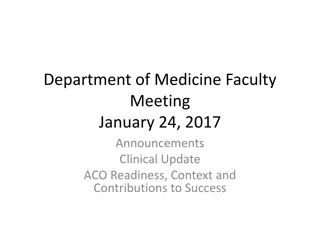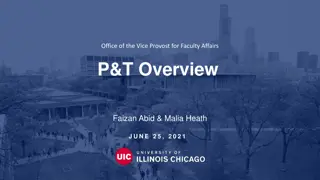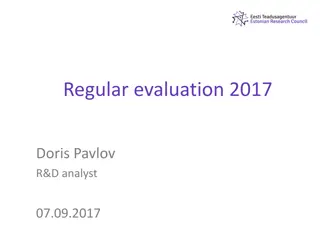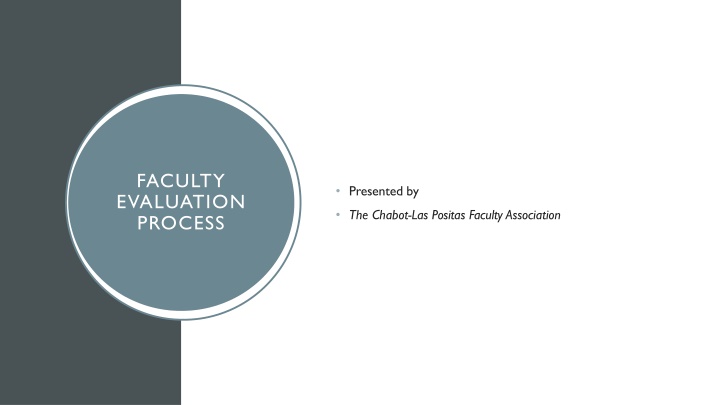
Faculty Evaluation Process Guidelines at Chabot-Las Positas Faculty Association
Explore the Faculty Evaluation Process presented by The Chabot-Las Positas Faculty Association. Understand the objectives, processes, and required information for faculty evaluations. Detailed guidelines are provided for contract faculty, both tenured and untenured, as well as part-time and distance education instructors.
Download Presentation

Please find below an Image/Link to download the presentation.
The content on the website is provided AS IS for your information and personal use only. It may not be sold, licensed, or shared on other websites without obtaining consent from the author. If you encounter any issues during the download, it is possible that the publisher has removed the file from their server.
You are allowed to download the files provided on this website for personal or commercial use, subject to the condition that they are used lawfully. All files are the property of their respective owners.
The content on the website is provided AS IS for your information and personal use only. It may not be sold, licensed, or shared on other websites without obtaining consent from the author.
E N D
Presentation Transcript
FACULTY EVALUATION PROCESS Presented by The Chabot-Las Positas Faculty Association
Article 14Contract (Untenured) Faculty Evaluation Article 15 Regular (Tenured) Faculty Evaluation CONTRACT ARTICLES Article 18I Part-Time Faculty Evaluation Article 19 Distance Education
The evaluation process is designed to assist unit members in examining their objectives, techniques, and accomplishments and to provide a means to recognize outstanding performance, a means to identify areas in which changes might be beneficial to student learning, and a two-way channel of communication about program needs. OBJECTIVE OF EVALUATION -excerpt form Article 15A & 18I
Collect needed information Schedule of classes Syllabi BASIC PROCESS Course outline Observation form Other pertinent material(s)
ARTICLE 14 CONTRACT FACULTY (TENURE TRACK) Discuss assignment schedule with Tenure Review Committee and determine which three (3) classes or activities will be observed. Should include as much of a cross-section of load assignment as determined to be beneficial to the Contract Faculty
(Also applies to Article 15 & 18 evaluations) Syllabus Syllabus Shall include Name, office number, phone and CLPCCD email address Office hours: virtual office hours and the method of office hours (email, zoom, etc.) Method of Final Grade Calculation Academic Calendar dates to know : W date; Final Exam time & date; deadline for Financial Aid (text or link) Other Supplemental Information, including safety requirements Student Learning Outcomes (SLO s) (text or link) Information about disability accommodations and campus services (text or link) Adding a link to the Student Services Hub will cover many of the items listed above. ARTICLE 14 CONTRACT FACULTY (TENURE TRACK) CONT D http://www.chabotcollege.edu/student-services/ https://www.laspositascollege.edu/studentservices/index.php
Syllabus contd Syllabus Should (encouraged, not mandatory) include information regarding: A statement of Students Rights and Responsibilities Expectations regarding behavioral standards per school policy A summary of course content and expectations (general course content, course objectives and prerequisites) Academic Integrity and Plagiarism Policies Attendance Policy ARTICLE 14 CONTRACT FACULTY (TENURE TRACK) CONT D (ALSO APPLIES TO ARTICLE 15 & 18 EVALUATIONS)
Mid-semester is optimal Provides time for instructor and students to have established rapport and understanding of class structure Provides opportunity for feedback to be useful immediately Provides time for follow up, if needed TIMING THE OBSERVATION
ARTICLE 18 PART-TIME FACULTY Items specific for Part-Time Faculty The Evaluator will notify the Evaluee a minimum of one (1) week before the observation takes place that they are a. being evaluated this semester and, b. the faculty member who will be performing the evaluation. The Part-Time Faculty member being evaluated is encouraged to provide relevant course information One week after the evaluee has been notified they are being evaluated and who their evaluator is, the visit for observation may be unannounced, but shall occur with the Part-Time Faculty member s consent If there is difficulty in coordinating the visit, the Evaluator and Evaluee shall schedule a specific visiting time
FEEDBACK Following the class visit, develop a report based on the class observation, including a summary of student surveys Arrange a time to meet with evaluee to provide feedback. Timelines are outlined in contract Satisfactory, Needs Improvement, Unsatisfactory Part-time 20 working days after classroom visit (Article 18I.1f) Tenured 20 working days after classroom visit (Article 15F.2.a) Untenured 20 working days after classroom visit (Article 14F.2.f) Evaluator should notify appropriate Administrator of the results prior to contacting the evaluee
Clarification of Contractual Peer Evaluations CVC-OEI: Peer Online Course Review (POCR) Chabot: Committee on Online Learning (COOL) Las Positas: Distance Ed Committee Evaluations conducted by the committees above are unrelated to faculty evaluations; these processes do not affect or inform faculty evaluations (19.F.1)
What to evaluate: View and discuss feedback with examples to demonstrate regular and substantive interaction strands, such as Inbox messages, Pronto, rubric feedback, or individual comments on graded Assignments Scope of Evaluation: Confirmed use of Syllabus, Home Page, and any other introductory content Review components for the chosen unit or module, including two weeks of content This can include assigned work, discussion boards, exams, any publisher comment ASYNCHRONOUS TOUR CHECKLIST Review of Reporting data that shows student engagement and instructor presence such as People page and selected Course Analytics (Course Grade, Weekly Online Activity) Example of Student-to-Student interaction methods, such as discussions, Pronto, live discussion, group assignments, reflections with peer feedback, or peer review (ARTICLE 19.F.1.D) Example of the course meeting accessibility standards Evaluator and Evaluee discuss and select/determine module for evaluation Module or selected review section shall be at least 20% into the course content (e.g. in a full-term class, at least the 4th week of the course or after) If prerequisites are used by evaluee Agreement about dates for prerequisites to be temporarily disabled for the given module Recommend that the selected module be one completed by students prior to the 72 hour evaluator access period if possible to minimize disruption to course schedule and flow
The evaluator shall be added to the course with customized Evaluator role or other LMS-specific defined role created for the purposes of course evaluation. The evaluator shall have access to the course for a maximum of seventy-two (72) hours unless the evaluee voluntarily agrees to extend this time limit. At the pre-arranged observation time, the evaluee will add the evaluator into the course site. The evaluee will also remove the evaluator using the same method. It is the responsibility of the evaluee to remove the evaluator s access The evaluator shall use for the purpose of evaluation course modules, content or lessons that cover a minimum of two weeks worth of instruction (19.F.2)
19E.1 COURSE ORGANIZATION AND NAVIGATION FOR ASYNCHRONOUS CLASSES In addition to Syllabus requirements in Article 9B, any portion of a course taught in Online Asynchronous format shall meet the following guidelines: 1. Course includes a distinct starting point and instructions on how to begin course. 2. Instructor contact information is easily located along with response times for email, grade turnaround, and other contact information. 3. Navigation and content flow are easily determined by students in the class. 4. Content is organized logically and follows a consistent layout and structure. 5. Content is segmented into distinct units or modules, as appropriate. 6. Course navigation menu is intuitive and only includes items students will use. 7. Clear due dates for submitting work are posted along with late work policy. 8. Opportunities for regular and substantive interaction from student to student and instructor to student(s) are provided. 9. Course design includes instructions for learners to work with content in meaningful ways (e.g. guiding students to take notes during a video, explaining what to look for in an article, etc.)
19E.2 SPECIFIC GUIDELINES FOR SYNCHRONOUS INSTRUCTION In addition to Syllabus requirements stated in Article 9B, any portion of a course taught in Online Synchronous format shall follow the following guidelines: a. The instructor shall provide a courseware shell (e.g. Canvas or the currently employed LMS) for the class and utilize shell to post important information for the class. In addition, the instructor is encouraged to utilize the course design principles described in Article 19E.1 (previous slide) as appropriate. b. Instructor uses either camera or other instructional media such as slides or videos during instruction. c. Recorded course content used in or saved to course site does not reveal personally identifying information for students in other course sections. d. Teaching on Zoom or using other synchronous tools follows best practices and encourages student participation. e. Instructor makes every effort to have consistent connectivity.
Specific Guidelines for Counseling In addition to on-campus student contact, counseling faculty shall service student needs virtually by using the agreed upon platforms: 1.Counselors shall follow the same protocol for scheduled virtual appointments as for in person appointments. 2. If no one is waiting for in person services, face to face counselors shall take students waiting for virtual appointments. 3. While using Cranium Cafe , or any other virtual counseling platform, the counselor shall be logged into the Cranium Lobby, or waiting room, during assigned times and invite students into meetings. 4. Use of conferencing software. Students experiencing technical difficulties with Cranium Cafe , or other virtual counseling platforms, shall be seen using other conferencing platforms, like Zoom or referred to a phone call if necessary. Counselors shall generate meeting invites and mail to student s Zone Mail account. During or after an appointment 1.The counselor shall know how to use and access all applicable software and college databases. 2.The counselor shall either address all student questions or schedule a follow up appointment. 3.The counselor shall have familiarity with all transfer patterns, eligibility requirements, including transferrable and non-transferrable courses. 4.The counselor shall enter data about the appointment in SARS.
1.The librarian shall know how to use and access all applicable software and library services and databases 2.Scheduled orientations shall be delivered synchronously or asynchronously in Canvas course shells at a time chosen by the librarian in consultation with the course instructor Specific Guidelines for Librarians 3.During scheduled librarian work hours, virtual services shall be delivered including appointments and live chat using library applications
Synchronous Class (F2F or online -- classes with scheduled meeting time): Evaluation: Observation of Instruction Form Face to Face Class (19F.1.b.) Asynchronous Class (classes without scheduled meeting times): Evaluation: Observation of Instruction Form Online Class Hybrid Class (classes with Asynchronous and Synchronous components) Only one delivery method may be evaluated. The delivery method (Asynchronous or Synchronous) with the greater percentage of the course content should be evaluated WHAT FORM SHOULD BE USED TO CONDUCT THE EVALUATION REPORT? If it is unclear which delivery method has a greater percentage of the course content the evaluator and evaluee should determine by mutual agreement the delivery method to be evaluated ARTICLE 14 CONTRACT FACULTY (TENURE TRACK) CONT D (ALSO APPLIES TO ARTICLE 15 & 18 EVALUATIONS) Majority Asynchronous delivery - Observation of Instruction Form Online Class Majority Synchronous delivery - Observation of Instruction Form Face to Face Class Counseling: Evaluation: Counseling Faculty Performance Observation Form Library: Evaluation: Library Faculty Observation Form Special Assignment: Evaluation: Special Assignment Faculty - Client Survey Form
Use approved forms only (Use the most updated Form) Forms are available online at the CLPCCD Human Resources web site http://districtazure.clpccd.org/hr/evaluations.php http://districtazure.clpccd.org/hr/evaluations.php Evaluate based on Standards in the contract for the type of evaluation Face-to-face instruction (Synchronous/Hy-Flex/Hybrid w/mostly Synchronous instruction) Online instruction (Asynchronous/Hybrid with mostly Asynchronous delivery of material) Counseling Library Special Assignment OBSERVATION There is no correct or minimum number of items that need to be marked or commented on
STUDENT SURVEYS For face-to-face observation: use approved scantron form (your admin asst likely has these) Must write a summary of student answers of open-ended questions A summary of student feedback from surveys is an important part of evaluation process For online observations: Student surveys will be deployed into Canvas sites by the Instructional Technology Coordinator EvaluationKit uses the same negotiated questions as the scantron Evaluators will receive the results of the survey once the survey period is complete. Nothing needs to be done by the Evaluator or Evaluee
Guiding Principle 1. The Faculty Contract DOES NOT require that student-surveys take place at the same time that the observation of instruction occurs during the evaluation process. 2. The Faculty Contract DOES require a timeline from when the observation of instruction takes place to the report of observation to be delivered to the evaluated faculty (20 days for all faculty) 3. Student Surveys are meant to inform the evaluation and are integral part of the process Period 1: Fast Track classes (8 week) that begin in the first half of the semester Survey Deployed: 9/16/24. Survey Ends: 9/27/24 Observation of online instruction may take place starting on Monday, Sept. 16,2024. Results to Evaluator: 10/4/24 Period 2: Full-term classes Survey Deployed: 9/30/24 Survey Ends: 10/11/24 Results to Evaluator: 10/18/24 Observation of online instruction may take place starting on Monday, Sept. 30,2024. EVALUATION OF ONLINE INSTRUCTION FOR FALL 2024 Period 3: Fast Track classes that begin in the middle of the semester Survey Deployed: 11/12/24 Survey Ends: 11/23/24 Observation of online instruction may take place starting on Monday, Nov. 12,2024. This Period may be used if necessary for full0term course evaluations that may have been missed in Period 2 Results to Evaluator: 12/2/24 For all evaluations: The Evaluator will need to calculate the number of working days (excluding Saturdays, Sundays and holidays) from the date of the observation of instruction to the delivery of the report to the faculty being evaluated The number of days for Contract (Tenure-Track) Faculty and Part-Time Faculty may not exceed 20 working days The number of days for Regular (Tenured) Faculty may not exceed 20 working days
SAMPLE EMAIL EXCHANGE FOR ACKNOWLEDGEMENT OF RECEIPT OF EVALUATION Re: Evaluation Summary for Evaluee From: Evaluee Sent: Thursday,October 22, 2020 1:01 PM To:Evaluator <evaluator@clpccd.org> Evaluator, I have received the evaluation documents that you sent. Thank you, Evaluee From: Evaluator Sent: Tuesday,October 20, 2020 8:09 AM To:Evaluee <evaluee@clpccd.org> Subject: Evaluation Summary for Evaluee Hi Evaluee, Attached is your completed evaluation form and summary for my classvisit on October 13, 2020 for your review. Please, respond to this email to acknowledge that you have received the evaluation, you may also attach a response to the evaluation if you choose. Thankyou, Evaluator
Maintain confidentiality in the evaluation process Results are to be discussed only with evaluee and dean/supervisor Let students know that evaluation is routine and part of an ongoing process, and that their feedback is important and anonymous Do not engage in discussion with students about the class or instructor. Do not bias the students by asking leading questions. Student evaluations are summarized by the evaluator to provide feedback to instructor; student evaluation forms are provided to instructor after semester is over and grades submitted Do not engage students while in the Canvas course shell CONFIDENTIALITY
QUESTIONS? Contact the following FA Officers if you have question about the evaluation process or procedures: Chabot Grievance Officer Chabot Vice President Las Positas Grievance Officer Las Positas Vice President President https://clpcfa.com/

